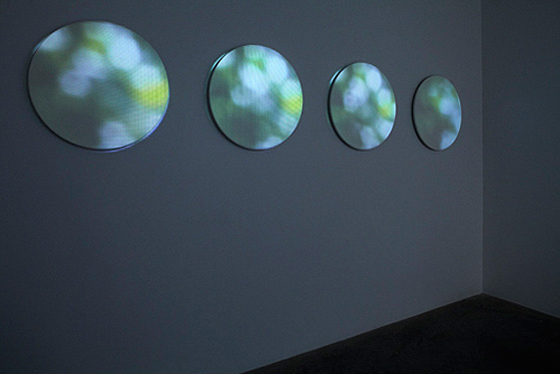With the Void
Stephen Andrews, Pierre Dorion, Dara Gellman
at Diaz Contemporary, Toronto
14 July – 27 August 2011

Dara Gellman “Reaching Out” Single channel video projection with stereo sound, 8mins loop, four MDF projection screens. Courtesy of the artist and Diaz Contemporary
“We wish to reassert the picture plane. We are for flat forms because they destroy illusion and reveal truth.†* This month Diaz Contemporary adorned its walls with works that, at first glance, echo ghostly epitaphs from the glorious manifestos of American abstract painters. On closer inspection the three-person show, made up of Stephen Andrews, Pierre Dorion and Dara Gellman, rises beyond the oppositions between figurative and non, into velvety sensory aesthetics. Similarly, when Color Field painters favored abstraction in the 1950’s, their focus, according to Clement Greenberg, was on illumination and openness: they elevated the potential of color to its apex via painterly techniques, large-scale formats, and thus rendered barren and featureless pictures to keep an open-ended subject matter. While clearly in continuation with this visual vocabulary, the works of With the Void journey to the limits of the representational tableau, and even reach out to confer with other media.

Pierre Dorion “Lagune” (2010) oil on linen. Courtesy of the artist and Diaz Contemporary
Dorion’s paintings result from carefully recreating personal snapshots, while stripping away photographic details down to their structural essence. After eliminating the formal elements that give away any signs of representation, only the compositional aspects of light and color remain, and come to the fore of Dorion’s work. Rich surfaces of shimmering color gradations sometimes blend into each other, while others are divided by dark horizontal lines. “Lagune†(2010) for example, joins up a black top half canvas and blue-green bottom with a sulfurous middle line, murky like steam rising from a bog at dusk. This artist’s mastery of color coordination is such that his works affect our perceptions to undeniably evoke the depth and substantive presence of bodies of water.

Stephen Andrews “Surfacing / Remains of the Day” (2010) oil on canvas. Courtesy of the artist and Diaz Contemporary
Andrews acknowledges an extensive experience in emulating the means of mechanical reproduction by exposing its hidden process. His canvases in this exhibition look and feel like an exploration into the chemical development of photography. Layers of color intertwine as oil and water, forcing uneven blobs to the surface. In places, pigments peering through each coat of paint provide a shiny texture akin to glaze on pottery. Conversely, the larger “Surfacing/ Remains of the Day†(2010) suggests a night sky, in a deep shade of midnight blue, blending into turquoise with plentiful white star-like dots emerging in irregular patterns. At play here again is our feeling of depth, while facing the flatness of Andrew’s thoughtful abstractions. Like the work of Dorion, Andrews’ paintings coax the viewer into pleasurable deceptions.

Dara Gellman “Reaching Out” (2008) Installation view. Courtesy of the artist and Diaz Contemporary
Gellman combines sound and image with her video projection installation “Reaching Out†(2008), accessible from the back of the gallery’s main space. In this darkened room four circular screens mounted in a horizontal array display blurry, pixilated and slow-moving shapes of green and brown color. Spinning on a loop, we hear the sounds of distant snapping, cracking and what could be the whistling of the wind, passing faintly through trees in a wet forest. The superbly associated units of Gellman’s installation assemble into a continuous ecosystem, an environment in which we feel welcome to simply contemplate. Just as Gellman’s organic imagery transforms coarse technological materials into a soft, natural space, the paintings of Dorion and Andrews also change the character of Diaz Contemporary Gallery, responding singularly to the bare walls around them. Whether by their riveting stillness or restrained technique, these works counter the viewer’s scrutiny with enough interpretative openness to hold our attention captive.

Installation view. Courtesy of Diaz Contemporary
The title of this show is inspired by Albert Camus, writing “With the void, full powers†** to describe his feelings on seeing the abstract art of Yves Klein. And likewise, instead of a conclusive mental image, we retain more of a cluster of unresolved cognitive leads from experiencing the collection of work in With the Void. Each piece is powerful in its ambivalence, in opening more than one window to the means of its understanding, leaving us uncertain of our conceptual foothold. Each artist here pursues deeply personal excursions in producing works of understated purpose, yet in recollecting colorfield art, they throw us a lifeline to find our way back from the void, and impose a limit on an otherwise infinite openness to pure abstraction. Having been to the edge of pictorial likeness and back, With the Void surely reasserts the continued relevance of the vocabulary of abstraction in contemporary art.
Text by Yaniya Lee
* p. 569, Art in theory, 1900 – 2000: An anthology of changing ideas by Charles Harrison
** “The Void†(1958) at Galerie Iris Clert in Paris, Klein emptied the gallery of all artworks and painting the walls white. Among those who attended the renowned exhibition was Albert Camus, who reacted with a notable entry into the visitors’ album: “with the void, full powers.â€
Diaz Contempoary
100 Niagra Street, Toronto
Ontario, M5V 1C5
Tel: 416.361.2972
www.diazcontemorary.ca

One Reply to “Review: With the Void”